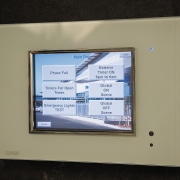Model workplace
The design of a vast manufacturing facility built five years ago has proved so successful that Fisher & Paykel Healthcare Corporation chose to repeat the formula for their latest project
Energy efficiency, a prime consideration for any business today, was a key factor in the design of the automated lighting system in the new Fisher & Paykel Healthcare building. The need for energy savings combined with flexibility, expandability, integration capabilities and user-friendly operation was instrumental in the decision to opt for a Clipsal C-Bus® control and management system.
Greg Bryant, commercial sector marketing manager for Clipsal Integrated Systems in South Australia, says the original O'Hare building had a Clipsal C-Bus lighting control system installed as part of the construction in 2001. The backward compatibility of Clipsal C-Bus provided Fisher & Paykel with the confidence to formulate a plan to incorporate full control and monitoring of the lighting in current and future buildings on the site from a centralised PC.
Bryant says ECOsystems, a key partner of Clipsal New Zealand, was integral to the successful implementation of the lighting control system, which is the largest Clipsal C-Bus installation in New Zealand.
"To ensure the smooth implementation of such a large-scale project, ECOsystems and Clipsal New Zealand worked beside the consulting engineers, architects and electrical contractor, Electrix. Together they designed a system that ensured Fisher & Paykel commenced operation with a system that met the lighting control needs of the various areas throughout the building."
ECOsystems provided project management of the lighting control installation, including on-site commissioning and full as-built documentation.
ECOsystems' Auckland-based C-Bus Systems Integrator, Robert Greenwood, says the automated system allows all lighting to be controlled by a single web browser, which simplifies the operation.
"If a system is simple to use, people will embrace the technology. The resulting energy savings will be good for the environment and financially beneficial to the organisation," he says.
The Clipsal C-Bus system consists of 12 networks with full control from a conveniently located colour touch screen. This enables easy manual control of all lighting throughout the entire building if required.
The lighting control throughout most parts of the building is a time-based operation that includes a regular shutdown of the lighting at the completion of regular business hours. Out of hours the lighting in the manufacturing, street, and office areas are activated by passive infra-red (PIR) occupancy detectors.
PIR detectors with custom time periods are also used to control lighting in the amenities areas. Training and meeting room PIR detectors have been set up so that Fisher & Paykel staff can disable the detector and have local control of the lighting to meet their specific needs when using these rooms.
The false ceiling area contains a large amount of plant, and effective lighting control was needed to ensure energy efficiency as well as a safe working environment. Localised timer controls at each entry point ensure a safe environment, and strategically located PIRs throughout the catwalk areas provide a high degree of energy efficiency.
Further energy savings are realised through the use of efficient fluorescent lighting controlled by PIR detectors in the warehouse and loading bay areas.
Rob Greenwood says the high ceilings in many areas created a challenge for the use of occupancy detectors, which needed to be carefully positioned. Other challenges presented by the project included the integration of the emergency lighting function with the fire system and power monitoring devices.
The need to meet tight deadlines was a key element in the success of the project ECOsystems staff worked irregular hours to complete a large part of the on-site commissioning of the lighting control system. The company also worked closely with Electrix to ensure areas of the building were operational as the building stages were completed.
For more information, contact Clipsal New Zealand, PO Box 51-317, Pakuranga, Auckland 1730, phone (09) 576 3403, fax (09) 576 1015. Email: commercialcbus@clipsal.com.au, or visit the website: www.clipsal.co.nz.
Or contact Frans Plugge at ECOsystems, ECO House, 59-61 Marsden St, Lower Hutt, phone (04) 566 3666. Email: fransp@eco.co.nz, or visit the website: www.eco.co.nz.
Story by: Trendsideas
Home kitchen bathroom commercial design






